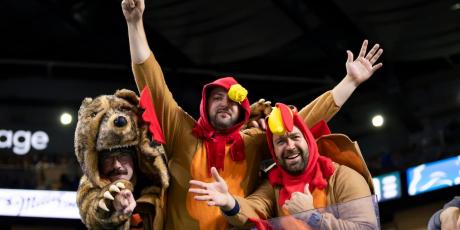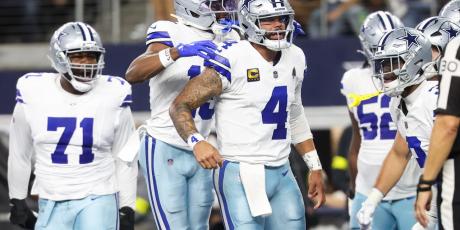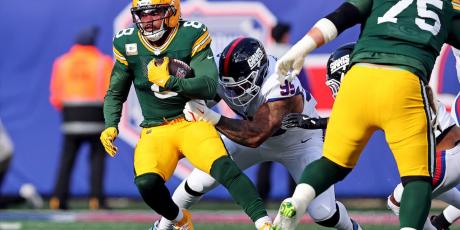What Offensive Coordinator Greg Olson Means for Jacksonville

Over the past few weeks, I have been combing through the history of offensive play callers that found new homes this offseason. You can keep up with all of my analysis on the impact of new play callers here.
I'm continuing this exercise with an in-depth look at the play calling history of the Jaguars new offensive coordinator, Greg Olson. Olson has spent eight years as an offensive coordinator in the league, but has only been the primary play caller in his last five seasons as an OC, so we will put our focus there.
Jacksonville is putting their offense in the hands of second year quarterback Blake Bortles, and Olson's history as a play caller has revolved around young quarterbacks. In 2009 in Tampa Bay, Olson helped groom rookie quarterback Josh Freeman, and they were together in Tampa through 2011. When he took the OC job in Oakland in 2013, Olson led an offense that used Terrelle Pryor and Matt McGloin under center, and last season Olson called plays for rookie Derek Carr.
A Snapshot of Olson's History
| Year | Total Yards | Points Scored |
|---|---|---|
| 2009 | 28 | 30 |
| 2010 | 19 | 20 |
| 2011 | 21 | 27 |
| 2013 | 23 | 24 |
| 2014 | 32 | 31 |
| Year | Att | Yds | TD |
|---|---|---|---|
| 2009 | 25 | 23 | 31 |
| 2010 | 13 | 8 | 24 |
| 2011 | 32 | 30 | 23 |
| 2013 | 16 | 12 | 7 |
| 2014 | 32 | 32 | 32 |
| Year | Att | Yds | TD |
|---|---|---|---|
| 2009 | 22 | 24 | 21 |
| 2010 | 23 | 17 | 11 |
| 2011 | 7 | 16 | 26 |
| 2013 | 25 | 24 | 29 |
| 2014 | 4 | 26 | 17 |
Glossing over Olson's past, we see a collection of offensive units that have been, in a word, bad. 2010 is the only year that a Greg Olson-led offense ranked in the top 20 in either total yards or points scored. His teams have only ranked in the top half of the league in rushing yards twice, and an Olson offense has never ranked in the top half of the league in passing yards. Given the makeup of his offensive rosters, this might not come as a surprise. Young quarterbacks tend to be very inefficient, and an inefficient passing game usually leads to an offense that struggles to score and is forced to play from behind.
One noteworthy trend is Olson's recent move to a more pass heavy offense. In two of his past three seasons as a play caller, Olson's units have ranked in the top 10 in pass attempts.
Positional Breakdown
Quarterbacks
| Completions | Attempts | Yards | TD | Int | FP/G |
|---|---|---|---|---|---|
| 19.7 | 33.7 | 215.7 | 1.2 | 1.1 | 14.1 |
| Year | Completions | Attempts | Yards | TD | Int | FP/G |
|---|---|---|---|---|---|---|
| 2009 | 17.4 | 32.6 | 195.9 | 1.1 | 1.8 | 10.3 |
| 2010 | 18.2 | 29.6 | 215.7 | 1.6 | 0.4 | 16.0 |
| 2011 | 23.1 | 36.7 | 239.5 | 1.1 | 1.5 | 13.4 |
| 2013 | 18.5 | 32.3 | 224.4 | 1.0 | 1.3 | 18.5 |
| 2014 | 21.8 | 37.4 | 204.4 | 1.3 | 0.8 | 12.0 |
Quarterbacks under Greg Olson have averaged just 14.1 fantasy points per game, a mark that would have ranked 21st among signal callers that started at least 8 games in 2014. Josh Freeman in 2010 is the only quarterback under Greg Olson to finish a season as a QB1 in terms of FP/G. (The 18.5 FP/G in 2013 accounts for all quarterback play, where Terrelle Pryor and Matt McGloin often rotated in and out during games.)
Again, much of the underwhelming fantasy output from the quarterback position can be attributed to young, undeveloped players. Given his past quarterbacks, and a second year Blake Bortles this season, maybe the most useful exercise is to focus on how Olson tends to distribute the ball among the skill positions with a young signal caller under center.
Running Backs
| Touches | Receptions | Total Yards | PPR FP |
|---|---|---|---|
| 14.0 | 1.6 | 64.3 | 10.0 |
| Year | Touches | Receptions | Total Yards | PPR FP |
|---|---|---|---|---|
| 2009 | 14.9 | 1.8 | 65.0 | 10.9 |
| 2010 | 15.8 | 0.4 | 78.5 | 10.5 |
| 2011 | 14.2 | 1.1 | 66.4 | 9.4 |
| 2013 | 13.3 | 2.4 | 68.3 | 11.6 |
| 2014 | 11.9 | 2.3 | 46.6 | 7.5 |
| Touches | Receptions | Total Yards | PPR FP |
|---|---|---|---|
| 8.5 | 2.0 | 39.5 | 7.0 |
| Year | Touches | Receptions | Total Yards | PPR FP |
|---|---|---|---|---|
| 2009 | 9.6 | 1.3 | 39.9 | 6.7 |
| 2010 | 10.7 | 2.9 | 49.5 | 8.8 |
| 2011 | 4.5 | 2.6 | 24.8 | 5.0 |
| 2013 | 13.1 | 1.7 | 48.7 | 9.4 |
| 2014 | 6.6 | 1.1 | 37.8 | 8.6 |
Whether because of injury or opting to take a hot hand approach, Greg Olson has almost always favored a committee in some fashion when it comes to his running backs. The lead back in a Greg Olson system has averaged 51.4% of the backfield touches, and Olson has had a running back start 14 or more games just twice. Even in those two seasons, his main back accounted for just 58% (Cadillac Williams, 2009) and 55% (LeGarrette Blount, 2011) of the running back touches.
In three of his five seasons as a play caller, Olson has had two running backs with at least 100 touches, and in 2014 Latavius Murray fell just one touch short of 100. Not only has a running back never finished as an RB1 under Greg Olson, no back has even finished in the top 24 in FP/G with Olson calling the plays. The 10 FP/G average by the "lead" back under Greg Olson would have ranked 28th among running backs who started at least 8 games in 2014.
Wide Receivers
| Receptions | Rec Yards | Rec TD | PPR FPs |
|---|---|---|---|
| 3.9 | 50.5 | 0.36 | 11.0 |
| Year | Name | Receptions | Rec Yards | Rec TD | PPR FP | PPR Rank |
|---|---|---|---|---|---|---|
| 2009 | Antonio Bryant | 3.0 | 46.2 | 0.31 | 9.5 | 46 |
| 2010 | Mike Williams | 4.1 | 60.3 | 0.69 | 13.8 | 24 |
| 2011 | Mike Williams | 4.1 | 48.2 | 0.19 | 9.8 | 45 |
| 2013 | Rod Streater | 3.8 | 55.5 | 0.25 | 10.8 | 46 |
| 2014 | James Jones | 4.6 | 41.6 | 0.38 | 10.9 | 44 |
Based on the cumulative offensive numbers and quarterback output, it's no surprise that the best FP/G finish by a Greg Olson wide receiver barely broke WR2 territory (Mike Williams, 2010). The 11 FP/G mark would have ranked 44th among wideouts in 2014. But rather than just saying that a certain skill position is bad, a more useful and actionable activity is to look at the distribution of passes to different receivers.
Under Greg Olson, the primary wide receiver has accounted for 18.7% of team receptions, and if we throw out 2009 when lead receiver Antonio Bryant caught just 39 balls for 13.9% of team catches, that market share number jumps to 19.9% for Olson's primary wideout. For context, Antonio Brown accounted for the highest amount of team receptions among receivers in 2014 with 31.6% and 24 receivers accounted for at least 19.9% of their team's catches last season. Of the 24 receivers that caught at least 19.9% of their team receptions, only six of those players failed to finish as a WR2 or better.
| Receptions | Rec Yards | Rec TD | PPR FPs |
|---|---|---|---|
| 2.6 | 36.6 | 0.21 | 7.4 |
| Year | Name | Receptions | Rec Yards | Rec TD | PPR FP | PPR Rank |
|---|---|---|---|---|---|---|
| 2009 | Sammie Stroughter | 2.4 | 25.7 | 0.08 | 5.4 | 91 |
| 2010 | Arrelious Benn | 1.7 | 26.3 | 0.13 | 5.3 | 101 |
| 2011 | Preston Parker | 2.5 | 34.6 | 0.19 | 6.7 | 79 |
| 2013 | Denarius Moore | 3.5 | 53.5 | 0.38 | 11.2 | 43 |
| 2014 | Andre Holmes | 2.9 | 43.3 | 0.25 | 9.4 | 63 |
The primary wide receiver under Greg Olson has been bad, but the second receiver has been down right atrocious. Denarius Moore was only the second wide receiver even close to usable for fantasy purposes with Greg Olson calling the plays. Inefficient quarterback play has hurt the value of the second wide receiver, but Greg Olson has tended to rely on the tight end as his true secondary pass catcher.
Tight Ends
| Receptions | Rec Yards | Rec TD | PPR FPs |
|---|---|---|---|
| 3.9 | 41.5 | 0.25 | 9.5 |
| Year | Name | Receptions | Rec Yards | Rec TD | PPR FP | PPR Rank |
|---|---|---|---|---|---|---|
| 2009 | Kellen Winslow | 4.8 | 55.3 | 0.31 | 12.3 | 8 |
| 2010 | Kellen Winslow | 4.1 | 45.6 | 0.31 | 10.6 | 9 |
| 2011 | Kellen Winslow | 4.7 | 47.7 | 0.13 | 10.1 | 14 |
| 2013 | Mychal Rivera | 2.4 | 25.4 | 0.25 | 6.4 | 39 |
| 2014 | Mychal Rivera | 3.6 | 33.4 | 0.25 | 8.3 | 20 |
As is often the case with young quarterbacks, the tight ends have been used as the proverbial security blanket with Olson as the play caller. Olson squeezed two TE1 finishes out of Kellen WInslow, Jr. and the 9.5 FP/G average by Greg Olson tight ends would have ranked 13th in 2014, or fringe TE1 numbers.
The primary tight end under Greg Olson has averaged 19.7% of team receptions and has accounted for 16% or more of team catches in four of Olson's five years as a play caller. Only five tight ends accounted for more than 19.7% of their team receptions in 2014, and 11 tight ends saw 16% or more of their team catches.
What This Means for 2015
Though Greg Olson hasn't had much success in terms of overall offensive rankings, he does have years of experience calling plays for young quarterbacks, and the Jaguars current roster fits Olson's general ball distribution philosophy.
While rookie T.J. Yeldon is expected to see the majority of the backfield touches, many projections, including John Paulsen's, still have a role carved out for Denard Robinson. Paulsen has Robinson projected for 121 touches, congruent with Olson's history of two 100+ touch backs.
In the passing game, Olson has generally relied on one wide receiver and his primary tight end. Allen Robinson looks to be the clear number one receiver for the Jags, and Jacksonville paid top dollar for tight end Julius Thomas in the offseason.
Based on Paulsen's projections for Blake Bortles and Olson's distribution history among his top receiver and tight end, we can come up with a rough range of outcomes for Robinson and Thomas based on their share of receptions. (This assumes even distribution of yards and touchdowns based on catches, which of course isn't the case but should suffice for illustration purposes.)
| % of Receptions | Receptions | PPR FP | Expected PPR Finish |
|---|---|---|---|
| 19.85% | 66.3 | 163.7 | WR45 |
| 22.50% | 75.2 | 185.6 | WR30 |
| 25.00% | 83.5 | 206.2 | WR24 |
| 27.50% | 91.9 | 226.8 | WR15 |
| % of Receptions | Receptions | PPR FP | Expected PPR Finish |
|---|---|---|---|
| 16.00% | 53.4 | 132.0 | TE18 |
| 19.70% | 65.8 | 162.5 | TE11 |
| 23.00% | 76.8 | 189.7 | TE6 |
Allen Robinson appears to be the most talented receiver Olson has worked with as a play caller, so the 19.9% average market share for WR1s under Olson is a fair floor. These ranges match up almost perfectly with John Paulsen's median PPR projections, so assuming Olson's historical ball distribution among his skill positions is more than reasonable. If Blake Bortles is even moderately better than expected, and Olson continues his recent trend of a more pass heavy offense, Allen Robinson might not be just a safe pick, but, given his price, could end up being one of the best values in fantasy football in 2015, and the player I will be targeting most on the Jaguars.












